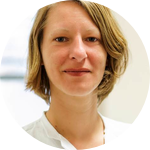Project Results
Support the Follow-On Study
What is the microbial composition of raw and processed placental tissue?
Introduction
Human maternal placentophagy, the behavior of ingesting the own raw or processed placenta postpartum, is a growing trend by women of western societies. This study aims to identify the impact of dehydration and steaming on hormone and trace element concentration as well as microbial contamination of placental tissue.
Methods
A total of nine placentas have been processed: six were studied for hormone and trace element concentrations; eight were studied for microbial contamination.
The concentrations of CRH, hPL, oxytocin and ACTH in samples of raw, steamed dehydrated and raw dehydrated placental tissue were detected using ELISA. A yeast bioassay was performed in order to detect estrogen equivalent (EEQ) and gestagen equivalent (PEQ) active substances. Elements (As, Cd, Fe, Pb, Se, Hg) were analyzed using ICP-MS. Isolated colonies from tissue and placenta swab samples were identified using Vitek MS.
Results
Following mean hormone concentrations were detected in raw placental tissue:
CRH (177.88 ng/g), hPL (17.99 mg/g), oxytocin (85.10 pg/g), ACTH (2.07 ng/g), estrogen equivalent active substances (46.95 ng/g) and gestagen equivalent active substances (2.12 μg/g). All hormones were sensitive to processing with a significant concentration reduction through steaming and dehydration.
Microorganisms mainly from the vaginal flora were detected on placenta swab samples and samples from raw, steamed, dehydrated and steamed dehydrated tissue and mostly disappeared after dehydration. According to regulations of the European Union the concentrations of potentially toxic elements (As, Cd, Hg, Pb) were below the toxicity threshold for foodstuffs.
Conclusion
The commonly used protocols for preparation of placenta for its individual oral ingestion reduce hormone concentrations and bacterial contamination.
About This Project
The human placenta contains a mixture of substances which may be useful for individual postpartum treatment. Until now, scientific research on the use of placenta remedies as a unique and cheap therapeutic treatment for women suffering from pathologies like anemia, depression or lactation difficulties, does not exist. To be able to discuss possible effects of placentophagy, the content of placental tissue has to be tested. The goal of this project is to analyze the hormones and elements from a sample size of 6 placentas to identify the bioactive molecules present.
Ask the Scientists
Join The DiscussionWhat is the context of this research?
Recently, a trend of mothers having capsules made from their own placenta for postpartal use can be observed in the US and in Europe. However, scientific evidence on the impact of placentophagy is rare.
On the subject of placentophagy, researchers often have contrary opinions; proponents claim various benefits whereas detractors state that intake is useless for humans.
Precise knowledge of the substances contained in placental tissue will allow a discussion on limitations and possible applications of placenta remedies.
What is the significance of this project?
Placentophagy could either cause a placebo effect or turn out be a cheap and effective medication for women suffering from postpartal diseases. Furthermore it could support an effective recovery from an exhausting childbirth.
Many women use placenta remedies without existing scientific research on the effects.
I want to introduce human placentophagy into the field of academic discussion. In order to be able to discuss possible effects of placentophagy, basic research is needed to determine which components and hormones can be found in placental tissue.
What are the goals of the project?
Placentas from spontaneous, unmedicated birth will immediately be prepared at the placenta lab for further analysis. Each placenta will be divided in half, of which one part will be dehydrated, the other part frozen. After a sample size of six placentas is collected, the material will be transferred to the food analytic laboratory where approximately 11-12 substances will be tested for.
I want to compare the contained amount of elements such as lead, iron and mercury. Furthermore, the amount of hormones such as CRH, oxytocin, human placental lactogen, estrogens and gestagens will be analyzed before and after the dehydration of placental tissue.
Budget
Laboratory Analysis: Usually bio fluids such as human blood serum are used for the analysis of hormones and other substances. In this special case, analysis from placental tissue is needed to determine the existence of substance before and after dehydration. This can only be done at a laboratory specialized in food analytics. I am delighted to have secured the cooperation of "Food GmbH Jena Analytik - Consulting" for this exciting project.
Dehydrator: A dehydrator is required for preparing the material for comparison of contained substances in raw and dehydrated placental tissue.
Endorsed by
Meet the Team
Affiliates
Sophia Johnson
In 2012 I graduated at the private University of Witten/Herdecke. In addition to my general medical studies, I attended courses in Anthroposophical Medicine, Phytotherapy and Traditional Chinese Medicine. As my interest in alternative medicine is broad, I am eager to include it into my scientific studies.
https://www.linkedin.com/in/dr-sophia-k-johnson-a83705b6/
https://www.instagram.com/placenta.universe/
Jana Pastuschek
Leiterin AG Plazenta-Perfusion
Jana.Pastuschek@med.uni-jena.de
Telefon: +49 3641 9-390852
Fax: +49 3641 9-390857
Prof. Dr. med. Udo Markert
Leiter Placenta-Labor
Forschungszentrum - Haus F2
Am Klinikum 1, 07747 Jena
Markert@med.uni-jena.de
Telefon: +49 3641 9-3908503
Fax: +49 3641 9-390851
Project Backers
- 115Backers
- 191%Funded
- $8,355Total Donations
- $72.65Average Donation




